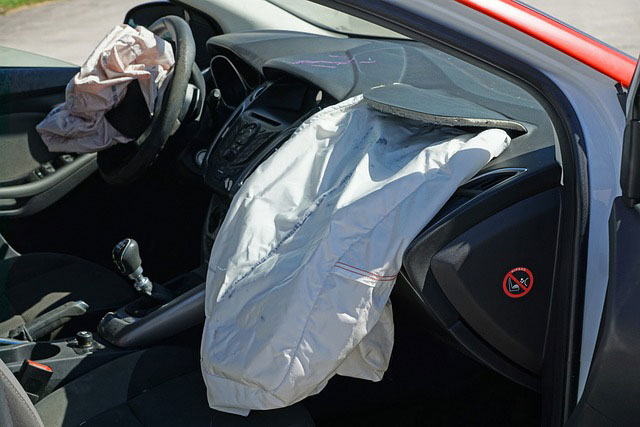In the ever-changing landscape of automotive safety, the evolution of airbags stands as a testament to mankind’s commitment to keeping people safe on the road. From their inception, airbags have undergone remarkable transformations to address the complexities of modern driving.
Today, airbags continue to spearhead car safety, collaborating harmoniously with other cutting-edge features to create an all-encompassing shield of protection. Want to learn more? Let’s get into it.

Table of Contents
The Evolution of Airbags
The journey of airbag development showcases the automotive industry’s commitment to enhancing safety for drivers and passengers. From their early beginnings as a groundbreaking safety feature, airbags have undergone significant evolution to meet the demands of ever-changing road conditions and crash scenarios.
Multiple Airbag Types
Gone are the days when a single frontal airbag was considered sufficient. Today’s vehicles are equipped with an array of airbag types strategically positioned throughout the interior. These include:
- Frontal Airbags: These airbags deploy in front-end collisions, protecting the driver and front passenger from striking the steering wheel, dashboard, or windshield.
- Side-Impact Airbags: Placed in the doors or seats, side-impact airbags shield occupants from lateral collisions, minimizing the risk of injury to the chest and abdomen.
- Curtain Airbags: These airbags drop down from the roof lining to safeguard occupants’ heads during side impacts and rollovers, reducing the risk of traumatic head injuries.
- Knee Airbags: Positioned beneath the dashboard, knee airbags provide protection to the lower extremities during frontal collisions, preventing leg injuries.
Advanced Sensors
The integration of advanced sensor technology has been a game-changer for airbag systems. These sensors gather data in real-time, allowing the airbag control unit to assess collision severity, occupant size, position, and even whether seat belts are fastened. By interpreting this data, airbags can deploy with varying force levels, ensuring that they are effective yet not excessive.
Smart Airbags
The dawn of smart airbag systems has ushered in a new era of occupant protection. These systems take into account factors beyond collision dynamics. They use sensors to detect the weight, size, and seating position of occupants, adapting the airbag’s deployment strategy to suit individual needs. For instance, if a child is seated in the front, the airbag might be designed to deploy with reduced force.
Seat-Integrated Airbags
To provide more precise protection during side impacts, seat-integrated airbags have been developed. These airbags are built into the sides of the seats and expand to shield the upper body and head. This innovative design minimizes the risk of injuries that could occur from contact with the door panel or window during a side collision.
Pedestrian Protection
Airbag technology’s impact extends beyond the vehicle itself. Some automakers are exploring the implementation of external airbags to protect pedestrians during collisions. These airbags are installed in the front bumper and deploy upon impact with a pedestrian, reducing the risk of serious head and chest injuries.
How Airbags Improve Car Safety
Reducing Impact Forces
Airbags act as a protective barrier between occupants and the vehicle’s interior surfaces. Upon impact, they inflate rapidly to cushion the force of the collision. By absorbing some of the kinetic energy, airbags reduce the severity of impact forces experienced by occupants. This, in turn, helps mitigate the risk of serious injuries, particularly to the head and chest.
Minimizing Contact with Hard Surfaces
In a collision, occupants may be forcefully propelled towards hard surfaces within the vehicle, such as the steering wheel or dashboard. Airbags effectively create a buffer zone that minimizes direct contact between occupants and these hard surfaces. This preventive measure significantly reduces the likelihood of abrasions, fractures, and internal injuries.
Collaboration with Seat Belts
Airbags and seat belts are complementary safety features that work together to enhance protection. Seat belts restrain occupants, preventing them from colliding with the airbag at high speeds. This collaboration ensures that occupants are positioned optimally for airbag deployment, minimizing the risk of injury while maximizing the effectiveness of both safety systems.
Enhancing Rollover Protection
Side-impact and curtain airbags are vital components of rollover protection. During a rollover, occupants can be subjected to multiple impacts as the vehicle rolls and hits various surfaces. These airbags create a protective cocoon that shields occupants from hitting the side windows or being ejected from the vehicle, reducing the risk of head injuries and fatalities.
Safer Environment for Children
Advanced airbag systems take into account the presence of child seats and the age and size of child occupants. By adjusting deployment parameters, these systems minimize the risk of airbag-related injuries to children. This approach of manufacturing airbags ensures that airbags remain a safety asset for all occupants, regardless of their age.
How Do I Know If My Airbag Works?
Ensuring the functionality of your vehicle’s airbags is vital to your safety on the road. Modern vehicles are equipped with advanced diagnostics that alert you to any potential issues with the airbag system. Here’s how you can determine if your airbag is in proper working condition:
- Check Dashboard Warning Lights: Upon starting your vehicle, the dashboard should display a light indicating that the airbag system is operational. If this light remains illuminated or flashes, it’s a sign that there might be a problem with the system.
- Scheduled Maintenance: Regular vehicle maintenance includes airbag system checks. During scheduled service appointments, technicians will inspect and diagnose any issues with the airbag sensors, wiring, or control unit.
- Diagnostic Scans: In the event of an accident or as part of routine maintenance, mechanics can perform diagnostic scans using specialized equipment. These scans can identify any errors or malfunctions within the airbag system.
What If My Airbag Doesn’t Go Off and I’m Injured?
While airbags are designed to deploy during certain collision scenarios, there are situations in which they may not activate despite an accident. If you find yourself injured due to an airbag not deploying as expected, here are the steps to take:
- Seek Medical Attention: Your health is the top priority. If you’re injured, seek medical attention immediately. Even if your injuries seem minor, it’s essential to have a medical professional assess your condition.
- Preserve Evidence: If it’s safe to do so, take pictures of the accident scene, your vehicle’s damage, and any visible injuries. This evidence can be crucial if you decide to pursue legal action.
- Seek Legal Assistance: If you believe that the airbag’s failure to deploy contributed to your injuries, it might be best to speak with a lawyer.
According to an attorney who focuses on product liability in Philadelphia, a lawyer can help provide you with the resources necessary to investigate and collect evidence to prove your product liability claims.
- Collect Documentation: Keep records of medical bills, repair receipts, and any correspondence with the manufacturer or dealership. This documentation will support your case and demonstrate the impact of the airbag’s malfunction.
The Journey Of Airbag Evolution
In 2023, the journey of airbag evolution is a remarkable testament to human ingenuity and determination. As the automotive landscape evolves, airbags persistently adapt, providing an ever-protective cocoon for occupants.
They stand as a shining example of how technology and innovation can collaborate to elevate safety standards, ensuring that each journey is met with an assurance of protection. With legal experts and innovative engineers working hand in hand, the road ahead promises to be safer, guided by the unwavering commitment to preserving life and well-being.













